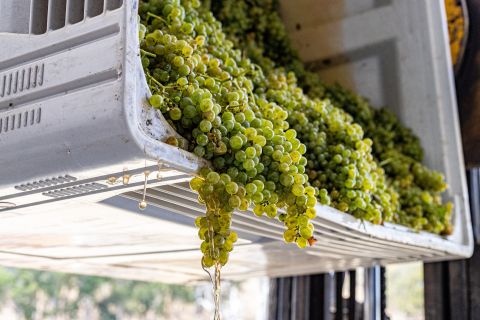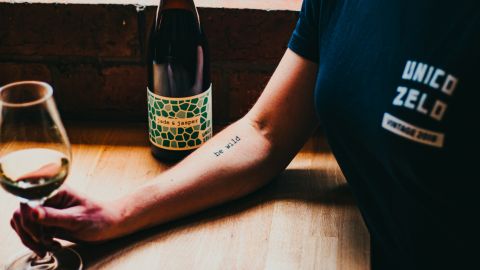‘It’s very crisp, saline, with a little floral note but not too much’, said the woman working the counter at my local wine store. Like you, I buy my wines at retail and have to rely on the expertise of the staff when faced with labels I’ve never seen before.
Prospect Wine Shop, you did me good here.
The wine is everything she promised, and more. More, because while it immediately bewitches with its light, fresh, crisp refreshingness, there’s real substance here, a broadness that fans out and fills every corner of the mouth and works its way into your head, where it lingers, teasingly, tempting you to revisit it with another sip.
More, because it was as delicious sipped on its own while making dinner as it was with dinner (risotto one night, clam pasta another, though it would have been just as good with anything that comes from the sea, all manner of fried things, a huge range of vegetable dishes, and lots of other things I’ve imagined since finishing that bottle …).
More, because it’s sustainably grown and made by a couple who’ve made a very real commitment to running a business in ways that respect both the land and its people.
Unico Zelo wines are made by Brendan and Laura Carter, who first met at the University of Adelaide, while he was studying oenology and she was studying agricultural science. She went off to Henschke to hone her wine chops while he finished his degree; then, in 2014, they launched their own winery, working out of a converted 1920s cold-storage facility in Gumeracha, an hour by car north-east of Adelaide, in the Adelaide Hills.
Sounds rather mundane so far. But right out of the gate, that very year, the two managed to win the Young Gun of Wine People’s Choice award on the back of their fresh, bright and entirely unexpected Fiano, their very first wine. Rather than focusing on the obvious (which is Shiraz and Riesling in those parts), the two began by looking to the unsung and underappreciated. Such as Fiano, of which there was a whopping 58 ha (143 acres) grown in 2014 according to Kym Anderson’s statistics.
Fiano, a high-acid grape indigenous to the southern Italian province of Campania, first went into Australian ground only in the early 2000s, when the Chalmers family planted some, as did Mark Lloyd at Coriole, who released the country’s first bottled example in 2006. Our Italian-wine critic Walter Speller tells the story of Lloyd’s Fiano attraction in Italian grape varieties in Australia, highlighting the fact that climate change was a primary impetus. As Lloyd said to Walter, ‘The acidity in Italian varieties is never a problem, it is almost always too high rather than too low’.
Indeed, Unico Zelo’s 2023 Jade & Jasper clocks in at 8.7 g/l acidity (with 2.3 g/l residual sugar) and has a pH of 2.99 – a level more common to steely Assyrtiko from Santorini than to most Australian white wines. And this from the Riverland, a region where the mean January temperature was 24.9 °C (76.8 °F) last year and only 181 mm (7 in) of rain fell over 12 months (yes, that’s less than the average in some deserts).
But for the Carters, finding a grape that can thrive in a desert without irrigation was only part of the story. Since the beginning, they’ve been incredibly bent on finding ways to support their land, and the Riverland is a place in need of a lot of attention. A vast, flat, heavily irrigated stretch of land on the south-eastern edge of South Australia that serves as the workhorse of Australian wine, it’s the country’s largest region by volume produced, growing 34% of Australia’s grapes in 2023. And 95% of that crush goes into bulk wines or low-priced blends; only 5% gets bottled under the Riverland GI.
So it’s essentially a faceless place, blended away into faceless wines, and it’s in trouble, as both crush volumes and prices have been falling over the last decade – 2023 recorded the smallest crush in the last 10 years, and the average purchase value of the grapes was AU$318/tonne, which is, as the Riverland Wine Industry Blueprint points out, below the cost of production for most growers. What’s more, water, once thought to be nearly unlimited from the River Murray, is looking precarious, with the increased plantings over the last decade combined with a changing climate leading to predictions of shortfalls of 25% to 60%.
Fiano, the Carters have realised, offers an opportunity to change this direction. It can – and does – grow in Riverland with no irrigation and no chemical inputs. Its price per tonne, thanks in large part to the popularity of this wine, has risen from an average value of AU$716 in 2019 to AU$1,078 in 2024 – offering grape-growers an opportunity to make a living rather than losing their shirts trying to sell commodity fruit at unsustainably low prices. All of the fruit for Unico Zelo’s Jade & Jasper Fiano comes from the Riverland – mainly from their long-time collaborators Ricca Terra vineyards, named Innovative Vineyard of the Year by Young Gun of Wine in 2020 for their hands-on, low-water, high-quality farming approach – and so the wine proudly bears a Riverland GI designation. And it’s not their only one: in their Fiano explorations, they’ve found the variety to be an expressive transmitter of terroir, and they now bottle from six to eight versions every year, including River Sand from Bassham Vineyards in Riverland, which sits alongside other small bottlings from more prestigious GIs, such as Clare and the Adelaide Hills.
That said, Jade & Jasper isn’t only a tool to raise the profile of Riverland and show the way to a more sustainable future there. It’s also, as they put it, the alpha and omega of the winery, the wine that’s allowed them to do everything else they do. Which is a lot. They became the first winery in Australia to achieve Certified B Corp status (in 2019 ), they also run Applewood Distillery, whose mission is ‘to conserve, discover and champion the irreplaceable flavours of the land we belong to while elevating locally farmed and sustainably sourced botanicals’, such as the wattleseed that flavours their vodka or the native plums and strawberry eucalyptus that punches up their Okar Bitter. It’s also a place they can give value to fruit that hasn’t found a home, buying it to turn into one of their distillates or vermouth.
They are so serious about sustainability that they’ve posted their (extremely detailed) sustainability initiatives online, so you can read about everything from their decision to replace pens with pencils (‘Sustainable newspaper pencils. Pens write 1 km, pencils write 56 km’) to their work on reducing bottle weights, purchased electricity and on-farm water use; their efforts to sustain their staff and support the community, as well as the challenges (sourcing sustainable alternatives to pallet wrap and affording organic certification, for instance).
They also clearly like to play: check out their YouTube channel, Wine for the People, or browse their ever-changing selection of wines, vermouth and liqueurs on offer (Unico Cello, an ultra-local version of limoncello, or Terra Cotta, an amphora-aged Greco, anyone?). And maybe this is what makes Jade & Jasper so successful: it’s a wine that comes from an ultra-serious desire to do right by the world, but also channels a sense of fun and irreverence in everything from its brightly coloured bagasse-paper labels to its palate-whetting zing.
In the US, the wine has a bit of a cult following thanks to the work of Epicurean Wines, their importer for the last eight years, and they are selling the 2023; in the UK, the wine is imported by Berkmann Wine Cellars, who are moving on to the 2022 vintage (currently available from Corking Wines) and will bring in 2023 as soon as the 2022s sell through.
All photos courtesy Unico Zelo.
Members can find another 300-plus notes on Fiano wines from around the world in our tasting notes database.

















